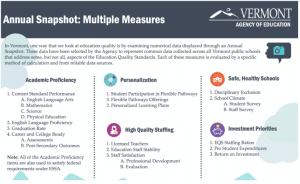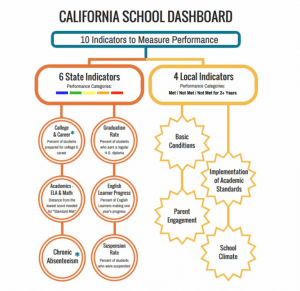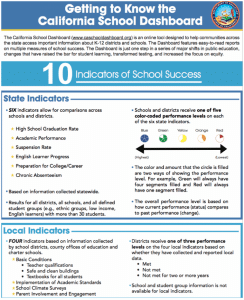Multiple Measures Data and Reporting in Vermont and California
CompetencyWorks Blog
 This post originally appeared at iNACOL on February 14, 2018.
This post originally appeared at iNACOL on February 14, 2018.
In personalized, competency-based education, schools should have far better data to support student learning, provide greater transparency and analyze and continuously improve on their practice through data and reporting with multiple measures. Likewise, states can consider how to present multiple measures of student learning and school quality with advanced data visualization to provide families with rich, easy to understand information.
What States Are Using Multiple Measures for Reporting Data and Continuous Improvement?
This post highlights how Vermont aligns multiple measures to the state’s student-centered learning priorities and to guide continuous improvement. This post also highlights California’s multiple measures dashboard as an example of providing information to different education stakeholders in the state.
Accountability for Continuous Improvement in Vermont
Under Vermont’s ESSA State Plan, the state will include multiple measures on school performance through five state priorities: safe, healthy schools; high-quality staffing; investment priorities; academic proficiency; and personalization. These priorities are aligned to Vermont’s Education Quality Standards, a series of policy guidelines requiring all schools to provide “educational opportunities which are substantially equal in quality, ensure continuous improvement in student performance…and annually report to the community.”
For each of the five priorities, the Vermont Agency of Education provides a series of guiding accountability questions and proposed reporting measures. The Agency will use a rating system from “near target” to “on target” to weight each measure against the state’s five core priorities.
ESSA requires all states to identify the lowest performing five percent of schools in a state for comprehensive school support (i.e., school improvement or turnaround). Vermont will use its rating system to identify its low-performing schools if they are performing “off-target” on a three-year cycle on the state’s first priority, academic outcomes.
Vermont’s rating system encourages a culture of continuous improvement. School leaders and educators are provided with guidance on how they can move closer to achieving the outcome target for their school and students. Vermont’s school rating system – while meeting ESSA’s requirement to identify the lowest performing schools for improvement – stands in contrast to models of accountability that rely on a single, summative rating of school performance.
Vermont’s Annual Snapshot: Multiple Measures illustrates the state’s five core priorities and the indicators in which all schools in the state will collect data. The Agency of Education in Vermont will use a rating system for these indicators that emphasizes continuous growth and improvement to meet all student outcomes at “on-target.”

Multiple Measures Accountability Dashboards in California
California’s School Dashboard is an example of establishing a balance in state and local roles in monitoring different school performance measures. The graphic below illustrates that districts will monitor the four local indicators to determine if they have “met, not met, or met for two or more years.” This information is gathered into a local dashboard, allowing district leaders to focus their efforts on evaluating and building school-level performance and capacity. The six state indicators are performance categories the state monitors as common measures of student outcomes. This approach allows the state to monitor the progress on the six indicators as they are reported through a statewide dashboard, in order to identify schools for comprehensive and targeted support.
California’s dashboard on multiple measures of school success, Getting to Know the California School Dashboard: 10 Indicators of School Success, provides schools and communities with information on how students are progressing on the state’s 10 indicators of school success. Six of the indicators are common across the state and collected by the state to monitor school performance and outcomes. The other four indicators are designed and collected by local education agencies and provide district and school leaders information on non-academic factors that could influence student learning outcomes and educator capacity that’s valuable for purposes of school support, early intervention and building educator capacity.
The California School Dashboard illustrates a first step states can take to provide transparent data on multiple measures to different education stakeholders in the state; however, this dashboard was not specifically developed to support competency-based education or student-centered learning. States may want to consider how multiple measure dashboards can be an iterative process to advance student-centered learning.
Under ESSA, states have an opportunity to rethink accountability systems and move from measuring one point of proficiency at one point in time, to understanding the transparency of data on student proficiency in real time, in addition to on each student’s growth toward high standards over time. States can use multiple measures to ensure transparency and continuous improvement when designing accountability systems.
See also:

